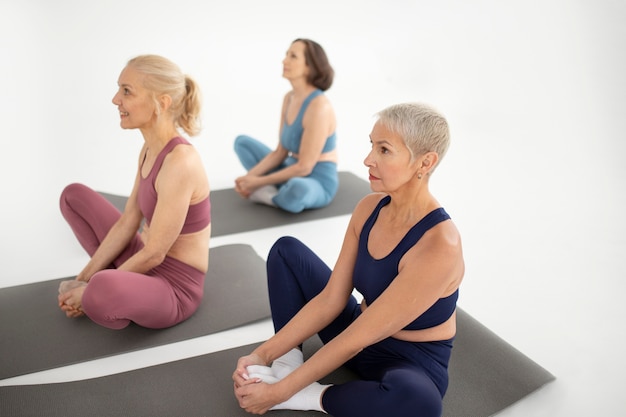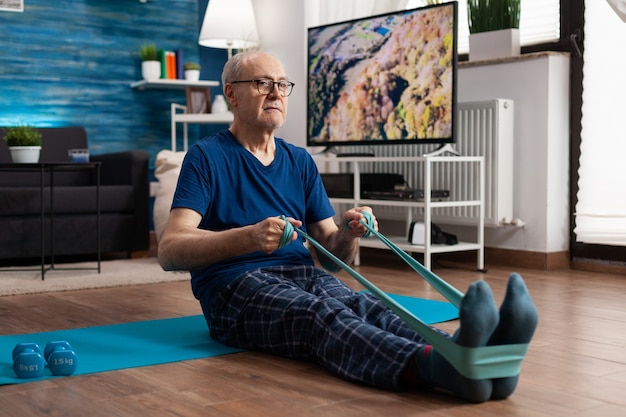Staying Active After 70: Low-Impact Exercises for Mobility

Staying active after 70 involves low-impact exercises designed to improve mobility and balance, helping seniors maintain independence and overall well-being.
Staying Active After 70: Low-Impact Exercises to Improve Mobility and Balance is essential for maintaining a high quality of life. Discover simple yet effective exercises to keep you moving and feeling great.
The Importance of Staying Active After 70
Maintaining an active lifestyle becomes increasingly vital as we age. After turning 70, regular physical activity can significantly impact overall health and well-being.
It’s not about running marathons; it’s about incorporating simple, low-impact exercises into your daily routine to keep your body moving and your mind sharp.
Benefits of Regular Exercise
Engaging in regular physical activity offers a multitude of benefits for seniors. These benefits include:
- Improved cardiovascular health
- Increased muscle strength and endurance
- Enhanced balance and coordination
- Reduced risk of falls and injuries
Mental and Emotional Well-being
Besides the physical advantages, exercise also plays a crucial role in mental and emotional well-being. It can help:
- Reduce symptoms of depression and anxiety
- Boost mood and self-esteem
- Improve cognitive function
- Enhance social interaction
Staying active after 70 isn’t just about physical health; it’s about maintaining a fulfilling and independent life. Incorporating these habits into your routine will vastly improve your health and well-being.

Understanding Low-Impact Exercises
Low-impact exercises are gentle activities that place minimal stress on your joints. These exercises are perfect for seniors looking to stay active without risking injury.
These exercises will allow you to build and maintain strength, flexibility, and balance from the comfort of your own home.
What Makes an Exercise Low-Impact?
Low-impact exercises are characterized by the following:
- Minimal joint stress
- Controlled movements
- Reduced risk of injury
- Suitability for all fitness levels
Examples of Low-Impact Activities
Several activities are considered low-impact and are ideal for seniors. Some of these include:
- Walking
- Swimming
- Yoga
- Tai Chi
Adapting Exercises for Your Needs
Adapting exercises to suit your individual needs and abilities is crucial. If you have any health concerns, consult with your health care provider before starting a new exercise program. Remember, the goal is to stay active in a way that feels comfortable and safe for you. This will allow you to develop and maintain a great active routine for yourself.
Chair Exercises for Mobility
Chair exercises are excellent for seniors who have limited mobility or balance issues. They provide a safe and effective way to strengthen muscles and improve flexibility.
These chair exercises can easily be performed at home, requiring minimal equipment and offering maximum comfort.
Seated Leg Extensions
This exercise helps strengthen your quadriceps. Here’s how to do it:
- Sit upright in a sturdy chair.
- Extend one leg straight out in front of you, parallel to the floor.
- Hold this position for a few seconds, then slowly lower your leg back down.
Seated Arm Raises
This exercise improves shoulder and upper back strength:
- Sit upright in a chair with your feet flat on the floor.
- Hold your arms straight out in front of you at shoulder height, then slowly raise them overhead.
- Lower your arms back to the starting position.
Seated Marches
Another great cardio exercise you can perform in a chair is:
- Engage your core and maintain good posture, sitting tall, not slouching, in order to activate the right muscles.
- Raise your knees one at a time in a marching fashion.
- Swing your arms in coordination with your legs.
- Perform for 1-2 minutes, rest as needed.
Chair exercises offer a practical and accessible way to maintain mobility and strength. By incorporating these exercises into your daily routine, seniors can improve their physical health, boost their confidence, and continue to achieve their health and wellness goals.

Balance Exercises to Prevent Falls
Balance exercises are crucial for preventing falls, one of the most common causes of injury among seniors. Improving your balance can significantly reduce the risk of accidents and help you maintain independence.
Balance is important for stability and coordination, both of which contribute to a better sense of physical confidence and overall well-being.
The Importance of Balance
Maintaining good balance helps you:
- Walk safely
- Climb stairs
- Prevent falls
- Enhance overall stability
Simple Balance Exercises
Here are a couple of easy balance exercises you can try:
- Heel-to-Toe Walking: Walk in a straight line, placing the heel of one foot directly in front of the toes of the other foot.
- Standing on One Foot: Hold onto a sturdy chair or wall for support, and lift one foot off the ground. Try to maintain your balance for as long as possible.
- Rock the Boat: Stand with your feet shoulder-wealth apart, then shift your weight back & forth from your heels to your toes, respectively.
Balance exercises are essential for maintaining stability and preventing falls. By incorporating these simple exercises into your routine, seniors can improve their overall balance and reduce their risk of injury, helping them live healthier, more independent lives.
The Role of Stretching in Flexibility
Stretching improves flexibility, reduces muscle stiffness, and enhances your range of motion. Regular stretching can make everyday tasks easier and more comfortable.
Stretching is an important component of overall fitness and can contribute to a greater sense of physical well-being.
Benefits of Stretching
Regular stretching:
- Improves flexibility
- Reduces muscle stiffness
- Enhances range of motion
- Prevents injuries
Effective Stretching Exercises
Some effective stretching exercises include:
- Shoulder Stretches: Gently stretch your arms across your chest to stretch your shoulders.
- Hamstring Stretches: Sit on the floor with your legs extended and reach for your toes.
- Calf Stretches: Stand facing a wall, place one foot slightly behind the other, and lean forward.
Stretching is a vital part of maintaining flexibility and overall physical health. These simple stretches will vastly improve your range of motion, which will lead to better performance during exercise.
Staying Motivated and Consistent
Staying motivated and consistent with your exercise routine is essential for achieving long-term benefits. Set realistic goals, find activities you enjoy, and make exercise a part of your daily life.
Consistency is key when it comes to maintaining a fitness routine. A little bit of physical activity each day can eventually add up to big personal achievements.
Setting Realistic Goals
Set achievable goals to stay motivated. Start small, get a baseline, and gradually increase the intensity and duration of your workouts:
- Start with short exercise sessions.
- Gradually increase the duration and intensity.
- Celebrate your progress.
Finding Activities You Enjoy
Choose activities that you find enjoyable to make your program.
- Try different types of exercises.
- Join a class or group.
- Make exercise social.
Making Exercise a Habit
Incorporate exercise into your daily routine to make it habit:
- Schedule exercise sessions.
- Combine exercise with other activities.
- Track your progress to stay motivated.
Listening to Your Body and Avoiding Injury
Listening to your body and avoiding injury is crucial for staying active safely. Pay attention to any pain or discomfort and modify your exercises as needed.
It’s important to distinguish between ordinary muscle soreness and severe indications of injury. Adjust rest times and intensity to maximize your fitness gains.
Recognizing Pain and Discomfort
Know the difference between normal muscle soreness and pain that indicates an injury:
- Pay attention to your body.
- Stop if you experience sharp or persistent pain.
- Modify your exercises as needed.
Preventing Injuries
Simple precautions can help prevent injuries:
- Warm up before exercising.
- Cool down afterward.
- Use proper form.
Consulting with Healthcare Professionals
When necessary, consult a healthcare professional to ensure optimal health:
- Talk to your doctor before starting a new exercise program.
- Seek advice from a physical therapist or certified trainer.
- Address any health concerns promptly.
| Key Point | Brief Description |
|---|---|
| 💪 Chair Exercises | Safe, effective for limited mobility, strengthens muscles and flexibility. |
| 🤸 Balance Exercises | Prevents falls, improves stability; heel-to-toe walking. |
| 🧘 Stretching | Enhances flexibility, reduces stiffness, aids range of motion. |
| 🎯 Staying Motivated | Set realistic goals, enjoy activities for consistent exercise. |
FAQ
▼
Low-impact exercises include walking, swimming, chair exercises, and Tai Chi. These activities are gentle on the joints and suitable for all fitness levels.
▼
Chair exercises provide a safe and effective way to strengthen muscles and improve flexibility without putting stress on your joints. They are ideal for those with limited mobility.
▼
Balance training helps prevent falls, which are a common cause of injury. Improved balance enhances overall stability and coordination, reducing the risk of accidents.
▼
Seniors should aim to stretch at least two to three times a week. Regular stretching improves flexibility, reduces muscle stiffness, and enhances range of motion.
▼
To stay motivated, set realistic goals, find activities you enjoy, and make exercise a part of your daily routine. Joining a class or group can also help with motivation and consistency.
Conclusion
Staying Active After 70: Low-Impact Exercises to Improve Mobility and Balance is a game-changer for enhancing the quality of life in senior years. By incorporating these exercises, seniors can maintain physical health, mental well-being, and overall independence, leading to a happier and more fulfilling life. Remember to always consult with healthcare professionals and listen to your body to ensure a safe and effective exercise routine.
